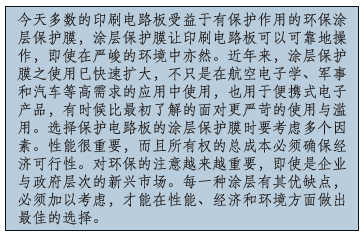
Balance cost, performance and environmental impact when selecting a conformal coating.
Many of today’s circuit boards benefit from the use of protective, yet environmentally “green” conformal coatings that allow them to operate reliably, even in harsh environments. The usage of conformal coatings has been rapidly expanding in recent years, not only in highly demanding applications such as avionics, military and automotive, but also in portable electronics that sometimes face more severe use – and abuse – than you might at first recognize.
Conformal coatings have a proven track record of protecting boards from dust and debris, liquids, and contact with a wide range of harsh conditions that they encounter. Such coatings must protect in very cold to very hot environments, and withstand vibrations and mechanical shocks that range from those encountered in automotive engine compartments to personal electronics that are frequently dropped, kicked, run over, and even immersed in the ocean. In all of these conditions, coatings must protect electronics from shorts and other damage.
Protective coatings work by closely conforming to surfaces, components, wire bonds and solder joints and forming a barrier to conductive contaminants. Additionally, they electrically insulate and isolate conductors that may be in close proximity to each other. An application of a coating to a PCB is shown in Figure 1. Conformal coatings are applied at the end of the assembly process, but like the components on the PCB, these coatings are most often selected early in the design process, based on specific performance requirements.
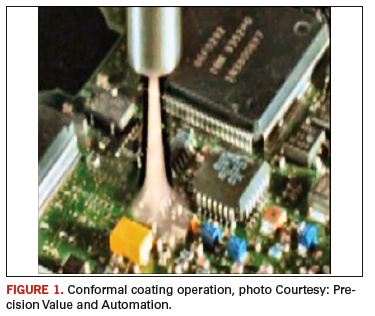
Even with greatly enhanced durability that can come from protecting electronics with a conformal coating, all too often such protection is added as an afterthought or as a last-minute correction to prevent failures brought to light by design-validation testing just before production launch. At this late stage in the game, only limited material characteristics can be considered, and trade-offs between performance, material price and production costs must be made very quickly. Ideally, such durability performance should be designed in from the start.
When improved reliability and durability requirements lead to coating choices made earlier in the commercialization cycle, designers can not only factor in board layouts that simplify coating application processes, but also consider the potential environmental and material regulatory aspects of their materials choice. There can be considerable differences in the possible environmental impacts of various coatings, and these differences may factor into the decisions of circuit board companies that want to improve the “green” credentials of their electronics.
There are many factors that go into the selection of the best conformal coating for a given application. Cost draws the laser focus of purchasing agents and buyers, and is the bane of suppliers’ sales agents. It is easy to concentrate on the price per kilogram of a material when considering various types of coatings, but that is only part of the total cost of ownership. Even materials that meet performance specifications may differ wildly on the cost associated with delivery, inventory, handling, dispensing, curing, waste handling, testing, scrap rates and warranty/ reliability/ durability in the final end use.
In Figure 2 the market share for the different types of coating materials is shown. Because of their low purchase price, acrylics are the largest volume coating used, but a low initial cost does not tell the whole story.
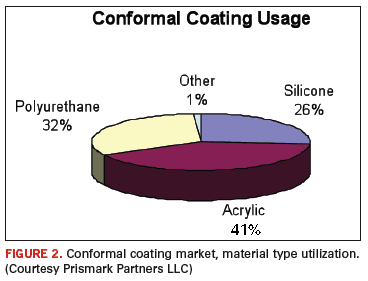
A solvent-based coating for instance, may offer a very attractive price per kilogram, but may require multiple application passes to obtain the same cured coating thickness – and therefore level of protection – as a solventless material. Additionally, there are costs associated with shipping, handling, storage, and the use of flammable and often toxic solvents. Moreover these same solvents transform into vapors during curing, and the vapors can often present additional issues to deal with. Also, most solvents are considered Volatile Organic Compounds (VOCs) and, in addition to having toxicological properties, they are recognized as contributors to ozone depletion and/or global warming. Finally, there may be considerable costs associated with the waste disposal of uncured (and sometimes cured) material.
Likewise, materials that require a curing oven not only add capital costs when setting up a production line, but also incur additional energy costs and likely add work for the HVAC of the manufacturing area. Ovens also add cycle time and work-in-process (WIP) costs that must be added to the total cost-of-ownership equation. The example in Figure 3 compares the total cost of two materials. Coating material 'A' had a lower price per kilogram, but ended up with higher processing costs and more rework and scrap costs. When the total cost to coat a board was calculated, the two materials had almost identical cost.

Other factors can include the cost of quality problems, measured by first-time reject and rework rates. On the other hand, improved profit margin in the form of superior reliability and durability for the end product can be achieved and enhanced by making the correct conformal coating selection.
Besides cost of purchase, performance criteria certainly must be met. Even here, just meeting product specification minimum requirements may not be an adequate criterion for choosing one coating versus another. For instance, a minimum coating-thickness requirement must be met to ensure adequate protection. However, nearly all coating application methods will produce varying thicknesses on a populated board. Vertical surfaces, wires, sharp edges and solder joints often will allow a coating to slump and sag, leaving far less coating and protection in those areas.
Boards may require differing levels of protection, depending on the environment in which they will be used. While board assemblers may try different coatings in pursuing a more perfect match of performance and value for a given application, there are additional costs when multiple coatings are used on a production floor. In some cases, using one product that meets the most demanding requirements for all coating lines may actually incur lower total costs when viewed through the larger picture of an entire plant’s operation.
Besides cost and performance, an increasing concern for lower environmental impact is affecting board assemblers’ decision making when evaluating conformal coating choices.
Solvents. Most production lines capture only a fraction of the solvent vapors given off by many coatings,and this applies particularly to acrylic coatings. These solvents are typically vented to the atmosphere where they are usually counted as greenhouse gases. Additionally, most solvents have noxious odors that are quite objectionable to workers – and to neighbors as well.
In addition to solvents within the coating formulation, some products, such as parylene, requires an adhesion promotion step that can involve large quantities of solvent that are released into the air and must be either captured or scrubbed before it is vented into the atmosphere.
Solventless coatings create far fewer volatiles or vapors, and therefore may contribute far less to environmental problems such as global warming. Parylene, urethanes and silicones are commonly available in solventless versions. In some cases, silicones are available in solvents that are not considered VOCs or greenhouse gases.
Toxicity. While nearly all materials can be considered as having at least some toxicological effects in certain concentrations or exposures, some coatings are recognized as needing greater care when handling, applying, curing and in the disposing of waste materials. Some acrylics and many urethanes can present significant challenges. Parylene and silicone have some of the least issues in this regard.
Operator Impact. Besides flammability and toxicology issues, worker exposure to unpleasant or noxious fumes and potential health problems due to skin contact are significant concerns. Parylene, which must be deposited under highly controlled vacuum conditions, is commonly applied only by specialized vendors. Silicones generally are more user-friendly than most conformal coatings.
Waste. When considering the environmental impact of a coating, the disposition of the waste associated with its application and use should be taken into consideration. While most spray, flow and dip-tank applications can limit waste to a relatively low percentage, parylene application can generate 90% or greater rates of material waste.
Environmental Stability. It is easy to overlook the disposal process of materials once they leave a manufacturing site. Organic carbon-based coatings will last a long time when used within their specification limits, but eventually they will degrade chemically, breaking down with exposure to sunlight, heat, ozone, bacteria and a host of other environmental conditions. Coating degradation causes the release of chemical components into the environment In Figure 4, the environmental impact of the various process steps is detailed. Silicones are widely recognized as having far superior stability to harsh and prolonged exposure conditions.
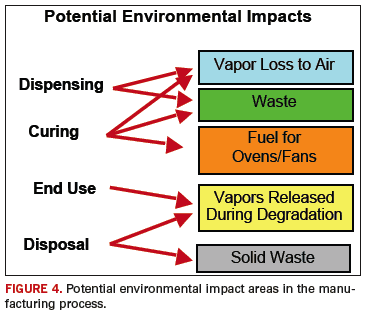
Environmental Impact. When carbon-based coatings do degrade, they release considerable carbon-content chemicals into the air and ground, since they are typically made up of greater than 90% carbon. However, since silicones are based on an inorganic mineral-like structure, they have far less carbon to release when they do eventually degrade. Typical silicones have only 33% carbon content (Figure 5).
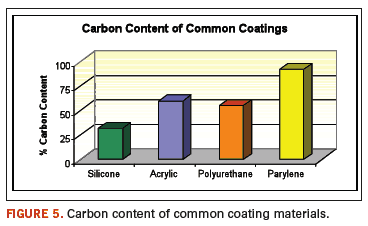
Many electronic applications have had to deal with lead-free regulations that have required use of alternative soldering materials. While reducing the potential environmental impact of lead, these regulations have caused other issues. One of the bigger problems has come from the higher tin content in solders. Under some conditions, tin will form “whiskers” and other phenomenon that can bridge between conductors, causing electrical shorts and failures. This has substantially reduced reliability and life expectancy on some circuit boards.
Several studies have shown that silicones have been one of the best conformal coatings at slowing the formation of tin-whiskers. Additionally, they also may deflect the growth direction, which can prolong the life expectancy of the electronic assembly.1
Conclusion
There are many factors that go into the selection of conformal coatings used to protect circuit boards. Performance is critical, and total cost of ownership must ensure economic viability. Environmental “green” concerns are growing in importance, even in emerging markets at both the corporate and governmental levels. Each type of conformal coating has its own set of benefits and detractors that must be considered to make the best performance, economic and environmental choices.
Acrylics have a very low price, but many contain undesirably high levels of solvents that pose significant flammability, toxicological, and environmental concerns. Their low price may well be offset when looking at the total cost of ownership and environmental impact.
Urethanes offer expanded performance at an intermediate price, but health and safety concerns can seriously compromise their perceived value and the full costs of use. When urethanes degrade, they can release high levels of both carbon- and nitrogen-based chemicals into the environment.
Parylene is a specialty coating whose total cost of use can be extremely high. It also has by far the highest material waste associated with typical protective coating applications.
Silicones have a high purchase price, but their ease of use, high performance, superior stability, relatively low environmental impact, and the increased reliability improvements for circuit boards can often reduce their total cost to the same or even less than other common coatings. PCD&F
REFERENCES
1. Evaluation Of Conformal Coatings As A Tin Whisker Mitigation Strategy, Part I & II, Thomas A. Woodrow and Eugene A. Ledbury, The Boeing Company, Seattle, WA.
Kent Larson is a senior engineer within the Electronics Global Application Engineering Center at Dow Corning Corporation and can be reached at This email address is being protected from spambots. You need JavaScript enabled to view it..



















